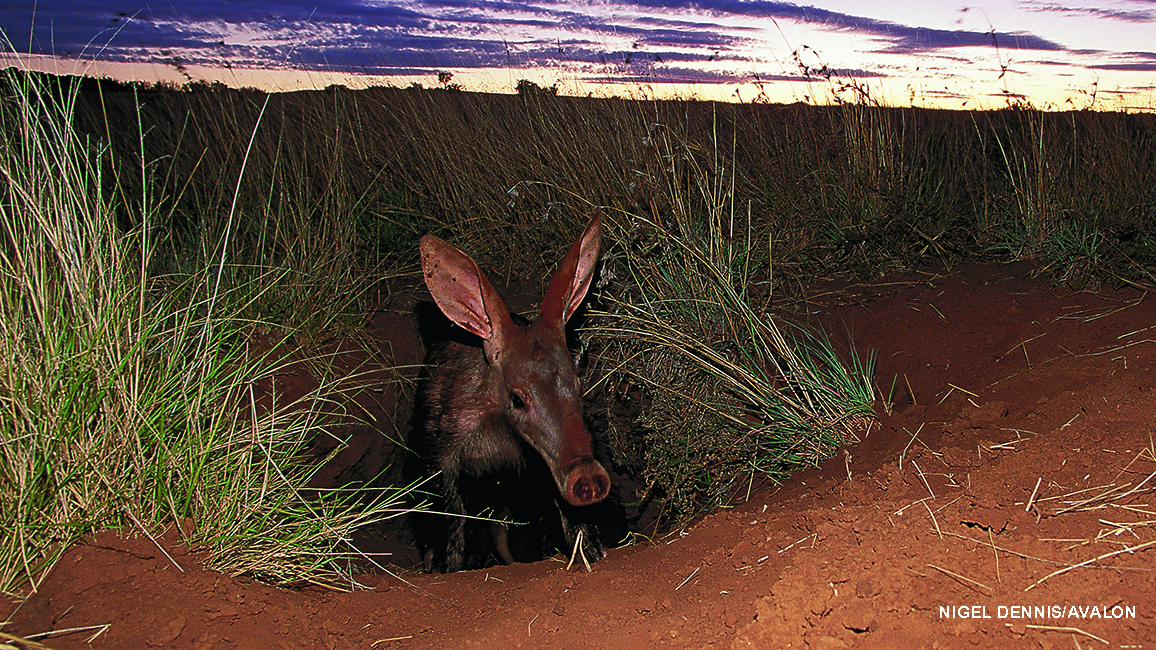
Life in the Dirt: Aardvarks
By Kate HofmannIt has big ears like a rabbit’s and a snout like a pig’s, but it’s more closely related to an elephant. It’s the one-of-a-kind aardvark!
Ąs darkness falls, the aardvark (ARD-vark) in the photo above emerges from a hole in the ground. It has been sleeping all through the hot African day, curled in a ball in its burrow. Now that the cool night is here, it’s time to wake up.
The aardvark’s large ears perk up, tuned to any danger. It sniffs the air with its long snout. When it’s sure that all is clear, it trots out to begin a night’s work.
An aardvark makes its living by digging, and it does that very well. Its large, powerful claws are shaped like shovels. The aardvark can dig a hole two feet deep in just 15 seconds. What for? To get to the ants and termites that are its favorite foods!

ANT-EATING CHAMPS
There are plenty of ants and termites where aardvarks live. But it can be tricky to make a meal of them unless you have the right body parts. Here’s how an aardvark beats the challenges:
1. Find food in the dark. The aardvark’s small eyes don’t see well, but its sharp hearing and a keen sniffer lead the animal right to the nests of ants and termites.
2. Break into the nests. Termite mounds can be as hard as concrete. Ant nests are usually in softer soil. But neither nest is a problem for the aardvark. It just uses its sharp claws to dig-dig-dig until it gets to the tasty treasure within!
3. Eat enough for a full meal. An aardvark is as big as a pig, but ants and termites are tiny. The insects also run really fast. Good thing an aardvark has a super-long tongue covered with sticky saliva. The tongue can slurp up as many as 50,000 insects in one night.
4. Don’t let the bugs bite! Ants and termites bite, but an aardvark isn’t bothered. Its skin is thick and tough. It can also close up its nostrils so that insects and dirt don’t get inside.

FRIENDS, FOES, AND FAMILY
Aardvarks don’t spend a lot of time with other aardvarks. Each one makes its own burrow. During the mating season, males may meet up to fight over who gets to mate with a female. Then the female later gives birth to a small, hairless baby down in her burrow. After about two weeks, the baby starts coming out of the burrow at night with its mom. By the end of its first year, the young aardvark can handle life on its own.

ON DEFENSE
While hunting for food, aardvarks have to watch out for predators: animals that might be hunting them! These include lions, cheetahs, leopards, hyenas, wild dogs, and pythons. An aardvark can run surprisingly fast. It can also quickly dig itself underground for safety. If it runs out of time to dig, it just flips onto its back and uses its sharp claws to slash at the attacker.
AARDVARKS ARE IMPORTANT
Aardvarks eat only some of the insects in each nest they dig up. Once a nest is opened, other kinds of insect-eaters—even those that don’t dig—can join the feast.
An aardvark doesn’t live its whole life in the same burrow. It moves around and makes new burrows in new places. The empty ones left behind become homes for many other kinds of animals. Warthogs, porcupines, hedgehogs, and jackals are just a few of the animals that may use them.
Because aardvarks mostly stay hidden in their burrows during the day, scientists aren’t exactly sure how many of them there are. But the animals don’t seem to be rare or endangered.
This might be bad news for ants and termites. But it’s good news for aardvarks and all the other animals that depend on them!
















